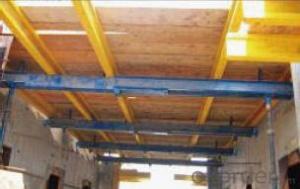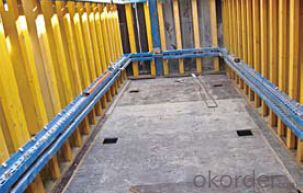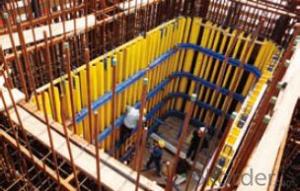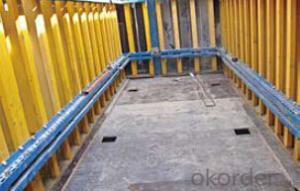Shaft-Platform for formwork and scaffolding system
- Loading Port:
- Tianjin
- Payment Terms:
- TT OR LC
- Min Order Qty:
- 50 m²
- Supply Capability:
- 1000 m²/month
OKorder Service Pledge
Quality Product, Order Online Tracking, Timely Delivery
OKorder Financial Service
Credit Rating, Credit Services, Credit Purchasing
You Might Also Like
Shaft Platform
As operating platform, the shaft platform is mainly used in the concrete pouring of elevator shaft,
equipment shaft, stair shaft of high-rise building and so on.
Characteristics:
◆ The length of shaft beam is adjustable.
◆ Flexible structure makes lifting easier.
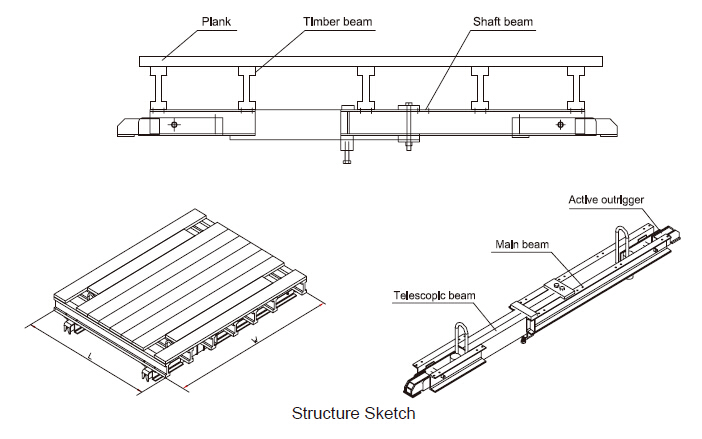
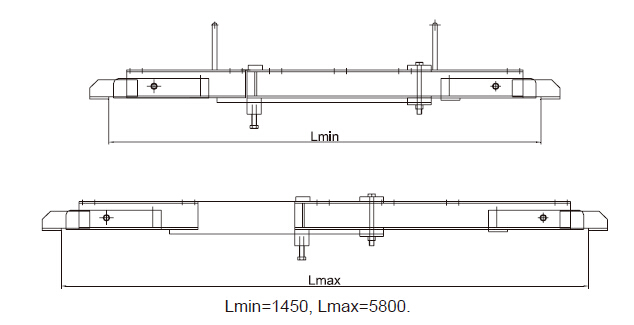
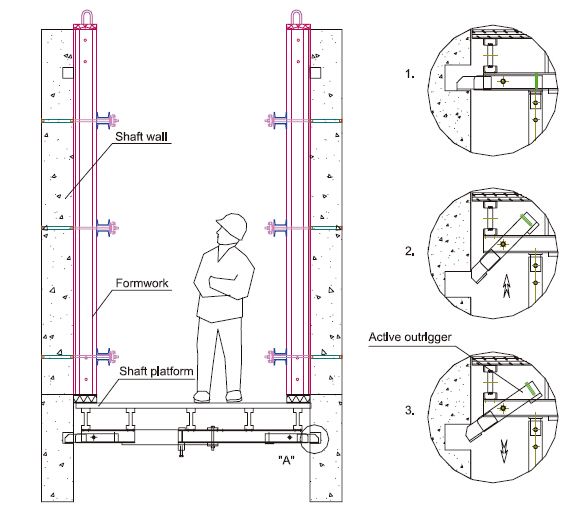
- Q: Are there any specific maintenance requirements for steel formwork systems?
- Yes, there are specific maintenance requirements for steel formwork systems. Steel formwork systems are used in construction to create temporary molds or frameworks for pouring concrete. These systems are designed to be durable and long-lasting, but regular maintenance is necessary to ensure their proper functioning and longevity. One important maintenance requirement for steel formwork systems is to regularly clean and remove any debris or concrete residue from the surfaces. This can be done by using a wire brush or high-pressure water jet to remove any hardened concrete or build-up. Cleaning the formwork prevents the accumulation of materials that can affect the quality and appearance of future concrete pours. Additionally, it is crucial to inspect the steel formwork system for any signs of damage or wear. This includes checking for cracks, dents, or rust on the steel components. If any damage is found, it should be repaired promptly to prevent further deterioration and to maintain the structural integrity of the formwork. Another maintenance requirement is to lubricate the moving parts of the steel formwork system. This includes hinges, locks, and adjustable parts that allow for easy assembly and disassembly. Lubrication helps to prevent corrosion, ensures smooth operation, and prolongs the lifespan of the formwork system. Furthermore, regular inspection of the formwork system's alignment and stability is necessary. This ensures that the formwork remains level and securely in place during concrete pouring. Any misalignment or instability should be addressed immediately to prevent accidents or structural issues during construction. Overall, proactive maintenance of steel formwork systems is essential to ensure their proper functioning, durability, and safety. Regular cleaning, inspection, repair, and lubrication are key to maintaining the quality and longevity of these systems, ultimately contributing to successful construction projects.
- Q: How does steel formwork perform in different weather conditions?
- Steel formwork is known for its durability and strength, making it a popular choice for construction projects in various weather conditions. In general, steel formwork performs exceptionally well in different weather conditions, including extreme heat, cold, and wet conditions. In hot weather conditions, steel formwork demonstrates high resistance to warping and deformation. It retains its shape and structural integrity, ensuring that the concrete is poured accurately and uniformly. The thermal conductivity of steel also helps dissipate heat quickly, preventing any potential damage due to expansion or contraction. Similarly, steel formwork performs reliably in cold weather conditions. It does not become brittle or lose its strength, ensuring the stability and safety of the construction. The low coefficient of thermal expansion of steel prevents any significant changes in dimensions, ensuring that the formwork remains intact and solid. When it comes to wet weather conditions, steel formwork exhibits excellent resistance to moisture. It is not susceptible to rot or decay, unlike wooden formwork. This makes it ideal for projects in regions with high humidity or frequent rainfall. Additionally, the smooth surface of steel formwork prevents water absorption, reducing the risk of concrete spalling or cracks caused by water ingress. Furthermore, steel formwork is highly resistant to corrosion, making it suitable for coastal areas or places with high levels of air pollution. Its protective coating prevents rusting and ensures a long lifespan, even in harsh weather conditions. Overall, steel formwork is a reliable and versatile choice that can withstand different weather conditions. Its strength, durability, resistance to temperature changes, and moisture make it an excellent option for construction projects, providing stability, safety, and longevity.
- Q: What are the different safety training requirements for steel formwork installation?
- The different safety training requirements for steel formwork installation typically include proper use and handling of equipment, knowledge of safety protocols and procedures, understanding of personal protective equipment (PPE), awareness of potential hazards and how to mitigate them, and training on emergency response and evacuation procedures. Additionally, workers may need to undergo specific training related to fall protection, scaffolding, and other specialized tasks involved in steel formwork installation.
- Q: Can steel formwork be customized for specific project requirements?
- Yes, steel formwork can be customized for specific project requirements. Steel is a highly versatile material that can be easily molded and shaped according to the specific needs of a project. This allows for the creation of various sizes, shapes, and designs to accommodate different construction requirements. Steel formwork can be easily modified or adjusted on-site to meet the specific dimensions and specifications of a project. Additionally, steel formwork can also be pre-fabricated off-site, where it can be tailored to the exact requirements of the project before being transported to the construction site. This customization of steel formwork ensures that it can be effectively used in a wide range of construction projects, including complex structures, high-rise buildings, bridges, tunnels, and more.
- Q: How does steel formwork contribute to the overall strength of the structure?
- There are several ways in which steel formwork contributes to the overall strength of a structure. To begin with, it provides a rigid framework that keeps the concrete in place while it is being poured and cured. This ensures that the concrete is contained and supported properly, resulting in a solid and uniform structure. Moreover, steel formwork helps to evenly distribute the loads across the structure. The steel panels and beams used in formwork are designed to withstand the pressure exerted by the wet concrete, ensuring that it is evenly distributed throughout the structure. This prevents any weak spots or areas of uneven load distribution, thus enhancing the strength and stability of the structure. Additionally, steel formwork reinforces the concrete. The steel panels and beams act as a reinforcement system, adding strength and durability to the structure. This reinforcement enables the structure to withstand external forces such as wind, earthquakes, and heavy loads, making it more resilient and resistant to damage. Furthermore, steel formwork allows for the creation of intricate and complex structures. Due to its high tensile strength and flexibility, steel can be easily shaped and molded into various forms. This versatility enables the construction of unique and architecturally appealing designs, enhancing the overall strength of the structure by tailoring it to withstand specific loads and forces. In conclusion, steel formwork contributes to the overall strength of a structure by providing a rigid framework, distributing loads evenly, reinforcing the concrete, and enabling the construction of complex designs. It plays a crucial role in ensuring that the structure is strong, durable, and capable of withstanding various external forces, making it a preferred choice in construction projects.
- Q: What is the process for installing steel formwork?
- The process for installing steel formwork typically involves the following steps: 1. Preparation: The site is cleared and leveled to ensure a smooth surface for the formwork installation. 2. Measurement and marking: The dimensions and layout of the formwork are measured and marked on the ground or existing structure. 3. Assembly: The steel formwork panels, which are designed to interlock, are assembled according to the marked dimensions. The panels are secured together using various connecting methods, such as bolts, clamps, or pins. 4. Alignment and leveling: The formwork is aligned and leveled using leveling devices, such as spirit levels or laser levels. This ensures that the formwork is perfectly straight and even. 5. Reinforcement placement: If required, steel reinforcement bars are placed within the formwork to strengthen the concrete structure. 6. Bracing and support: Additional bracing and support are installed to reinforce the formwork and prevent any movement during the concrete pouring process. 7. Concrete pouring: Once the formwork is in place and properly secured, concrete is poured into the formwork, filling the desired shape or structure. 8. Curing and removal: After the concrete has cured, the formwork is removed carefully to avoid damaging the newly formed structure. The removed formwork can be cleaned and reused for future projects if it is in good condition. It's important to note that the specific process may vary depending on the project requirements, design, and the type of steel formwork being used. Professional expertise and adherence to safety guidelines are essential during the installation process.
- Q: How does steel formwork perform in earthquake-prone areas?
- Due to its strength and durability, steel formwork is highly suitable for earthquake-prone areas. The material's resilience allows it to withstand the forces generated during seismic activity, and its excellent tensile strength enables it to resist bending and deformation. In order to ensure stability and safety in earthquake-prone regions, it is crucial to utilize reliable construction methods. Steel formwork provides a robust solution for constructing reinforced concrete structures that can withstand seismic activity. Its stability and rigidity contribute to the structural integrity of concrete elements, even in the face of strong ground shaking. In addition to its reliability, steel formwork offers flexibility in design and construction. It can easily be adjusted or modified to meet architectural and engineering requirements, which is particularly advantageous in areas where seismic resilience is a priority. Another benefit of steel formwork in earthquake-prone areas is its reusability. Being able to dismantle and reuse the formwork multiple times makes it a cost-effective and sustainable choice, which is especially valuable in regions with frequent seismic activity. Furthermore, steel formwork allows for better control over the quality of concrete structures. It helps achieve precise dimensions, shape, and surface finish, all of which are essential for seismic performance. The accuracy and consistency provided by steel formwork contribute to overall structural stability and reduce the risk of failure during earthquakes. Nevertheless, it is important to acknowledge that the effectiveness of steel formwork in earthquake-prone areas also relies on proper engineering design, construction techniques, and adherence to building codes and regulations. Collaborating with experienced professionals, including structural engineers, architects, and construction experts, is vital to ensure the successful utilization of steel formwork in earthquake-resistant construction.
- Q: Are there any specific design considerations for steel formwork construction?
- Yes, there are several specific design considerations for steel formwork construction. Firstly, the formwork should be designed to withstand the weight of the concrete and the pressure exerted during pouring. It should be structurally strong and rigid to prevent any deformation or collapse. Additionally, the formwork design should allow for easy installation, dismantling, and reusability, as steel formwork is often used in repetitive construction projects. Special attention should be given to the joints and connections to ensure stability and prevent leakage. Finally, proper surface finish and alignment should be considered to achieve the desired concrete finish.
- Q: Can steel formwork be used for shopping mall construction projects?
- Indeed, shopping mall construction projects can utilize steel formwork. The utilization of steel formwork is widespread in construction projects owing to its durability, strength, and adaptability. It provides a robust and inflexible framework capable of withstanding the pressures inherent in shopping mall construction projects. Furthermore, steel formwork allows for effortless customization and alteration, which proves advantageous when constructing intricate structures such as shopping malls. Furthermore, steel formwork yields a polished and top-notch finish, guaranteeing that the end result satisfies the aesthetic prerequisites of a shopping mall. In essence, steel formwork proves to be a suitable alternative for shopping mall construction projects due to its robustness, endurance, versatility, and aesthetic allure.
- Q: Can steel formwork be used for precast concrete elements?
- Yes, steel formwork can be used for precast concrete elements. Steel formwork provides durability and strength, making it suitable for manufacturing precast concrete elements. It allows for precise shaping and accurate dimensions, ensuring high-quality and consistent results. Additionally, steel formwork can be easily reused, making it a cost-effective option for precast concrete production.
Send your message to us
Shaft-Platform for formwork and scaffolding system
- Loading Port:
- Tianjin
- Payment Terms:
- TT OR LC
- Min Order Qty:
- 50 m²
- Supply Capability:
- 1000 m²/month
OKorder Service Pledge
Quality Product, Order Online Tracking, Timely Delivery
OKorder Financial Service
Credit Rating, Credit Services, Credit Purchasing
Similar products
Hot products
Hot Searches
Related keywords


